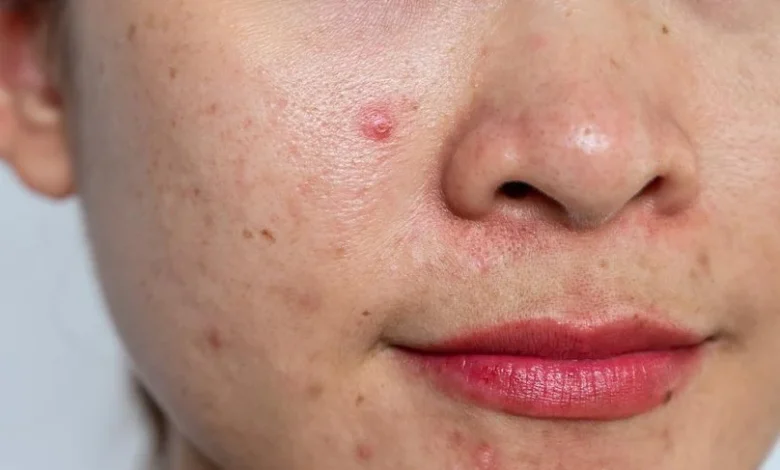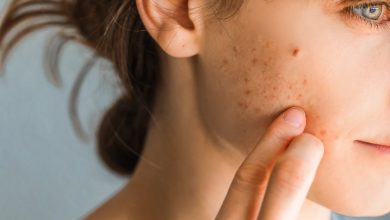Acne-Prone Skin? What is the best skincare routine for acne-prone skin?

Caring for acne-prone skin involves more than just using the right products; it can require changes to your lifestyle, as well. In this guide, we’ll cover how to identify your acne type, understand what triggers breakouts, and create an effective skin care routine tailored to your needs.

What Is Acne-Prone Skin?
Acne comes in two main forms: noninflammatory and inflammatory.
- Noninflammatory acne: This includes blackheads and whiteheads, which are caused by clogged pores. Blackheads have a dark appearance, while whiteheads are small, skin-colored bumps.
- Inflammatory acne: This type includes more severe forms like papules, pustules, nodules, and cysts, which are red, swollen, and often painful.
Acne can also be confused with rosacea, a chronic skin condition characterized by redness and pimples. While both conditions can co-occur, acne vulgaris is triggered by clogged pores, whereas rosacea has various causes, including genetics and environmental factors.
What Causes Acne?
Acne occurs when your pores become clogged with oil, dead skin cells, and bacteria. Several factors can contribute to this:
- Overproduction of oil, often due to hormonal changes
- Accumulation of dead skin cells
- Bacterial buildup
Hormonal changes during puberty, menstruation, pregnancy, or menopause are common causes of acne. However, acne can happen at any age and to any skin type, including dry or sensitive skin.
Understanding Your Skin Type
Knowing your skin type is key to addressing acne. Dermatologist Dr. Yoram Harth suggests this simple test:
- Wash your face with a mild soap.
- Gently pat it dry and don’t apply any products.
- After a couple of hours, observe your skin.
If it looks shiny, you likely have oily skin; flaky or red indicates dry skin; and if it’s oily in the T-zone (forehead, nose, chin) and dry on the cheeks, you have combination skin.
How to Prevent Breakouts
Preventing acne requires a balanced skincare routine and some changes to your daily habits. Here are some expert tips:
- Wash your face twice daily: Cleanse in the morning and before bed, especially after sweating.
- Be gentle: Avoid harsh scrubs or exfoliants that can irritate your skin and worsen acne.
- Don’t pick or pop pimples: Popping pimples can cause scarring and spread bacteria.
- Use noncomedogenic products: These are designed not to clog your pores, so look for labels that say “oil-free” or “noncomedogenic.”
- Clean anything that touches your skin: Change pillowcases regularly, clean your makeup brushes weekly, and wipe down your phone daily to prevent bacteria buildup.
- Stay hydrated: Drinking enough water can help maintain your skin’s natural balance.
The Ideal Anti-Acne Skincare Routine
A proper skincare routine can make a big difference in managing acne. Here’s a sample routine to consider:
Morning Routine:
- Cleanser: Use a gentle cleanser like Cetaphil Oil-Removing Foam Wash or Differin Daily Deep Cleanser for sensitive skin.
- Toner: Opt for an acne-friendly toner, such as Murad Clarifying Toner, to remove excess oil.
- Moisturizer: Even oily skin needs moisture. Try CeraVe Facial Moisturizing Lotion or Neutrogena Hydro Boost Water Gel for hydration without clogging pores.
- Sunscreen: Use a broad-spectrum SPF 30 sunscreen like La Roche-Posay Anthelios to protect your skin, especially if you’re using acne treatments that increase sensitivity to sunlight.
Evening Routine:
- Makeup Remover: If you wear makeup, ensure you remove it thoroughly with a gentle product like Bioderma Sensibio H2O Micellar Water.
- Cleanser: Use a face wash, like ArtNaturals Clarifying Face Wash, to cleanse away the dirt and grime from the day.
- Spot Treatment: Apply an acne treatment product such as Peter Thomas Roth Acne-Clearing Gel to target problem areas.
Weekly Add-ons:
- Exfoliant: If your skin can handle it, exfoliate once or twice a week with products like Nip + Fab Glycolic Fix Pads to remove dead skin cells.
- Face Mask: Use an acne-targeting mask, such as GlamGlow Supermud Clearing Treatment, to combat oiliness and reduce inflammation.
When to See a Dermatologist
If over-the-counter treatments aren’t improving your skin or if you have more severe forms of acne, it’s best to consult a dermatologist. They may prescribe medications like topical antibiotics, retinoids, or hormonal treatments like birth control pills or spironolactone.
Dermatologists also offer in-office procedures such as laser treatments or chemical peels that can help reduce acne and prevent scarring.
Taking care of acne-prone skin requires patience and the right approach. By identifying your skin type and understanding your acne, you can tailor a routine that keeps breakouts at bay and improves your overall skin health.






